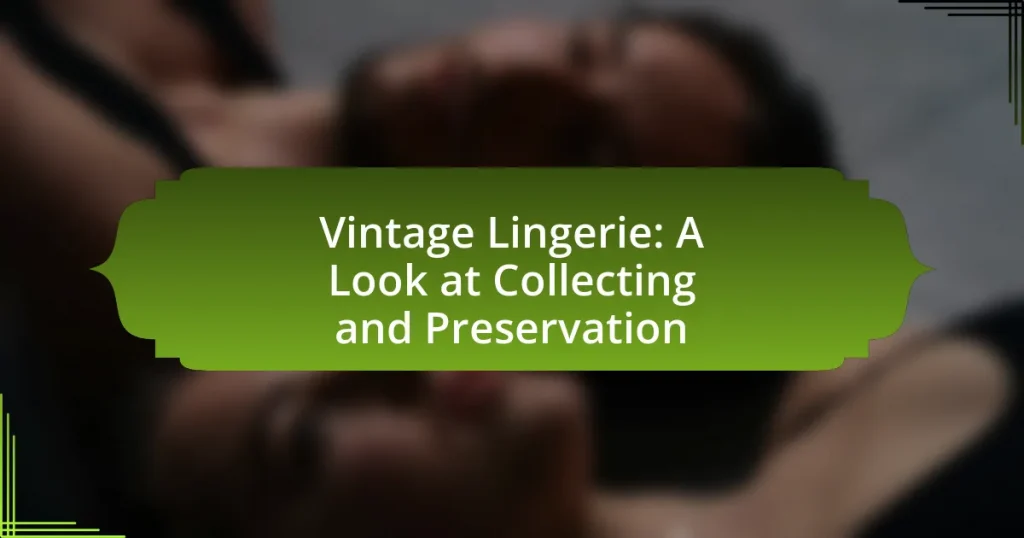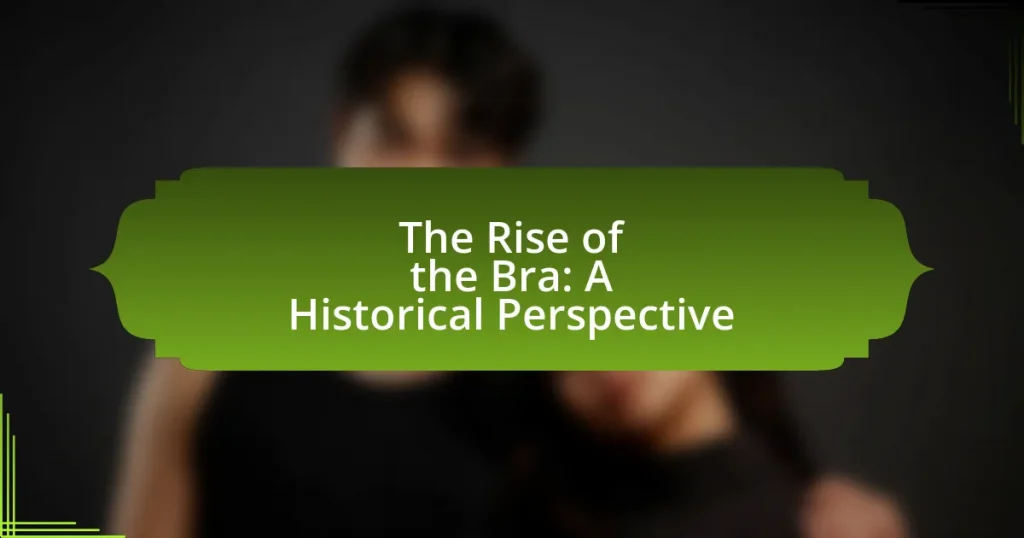Lingerie serves as a significant cultural and symbolic element in art and literature, representing themes of femininity, sexuality, and societal norms. The article explores how various artistic movements, such as Surrealism and Modernism, have utilized lingerie to challenge traditional representations of women and highlight the tension between public persona and private identity. It examines notable artworks and literary works that feature lingerie, discussing its evolving representation across different historical contexts and cultural attitudes. Additionally, the article analyzes the impact of feminism on perceptions of lingerie, its role in contemporary artistic expressions, and the insights gained from historical analysis for future explorations in literature and art.

What is the significance of lingerie in art and literature?
Lingerie holds significant cultural and symbolic value in art and literature, often representing themes of femininity, sexuality, and societal norms. In various artistic movements, such as Surrealism and Modernism, lingerie has been used to challenge traditional representations of women, highlighting the tension between public persona and private identity. For instance, artists like Man Ray incorporated lingerie into their works to explore eroticism and the subconscious, while writers such as Henry Miller and Anaïs Nin utilized lingerie as a motif to discuss desire and intimacy. This duality of lingerie as both an object of allure and a commentary on gender roles underscores its importance in shaping narratives around women’s experiences and societal expectations throughout history.
How has lingerie been represented in various art forms?
Lingerie has been represented in various art forms as a symbol of femininity, sexuality, and societal norms. In visual arts, such as painting and photography, lingerie often serves to highlight the female form and evoke sensuality, as seen in works by artists like Edgar Degas and Helmut Newton, who used lingerie to explore themes of intimacy and desire. In literature, lingerie appears as a motif that reflects characters’ identities and societal roles, often symbolizing liberation or constraint, as illustrated in novels like “Lady Chatterley’s Lover” by D.H. Lawrence, where it signifies both eroticism and social commentary. Additionally, lingerie has been a subject in performance art, where it challenges traditional gender roles and body image, exemplified by artists like Marina Abramović. These representations collectively underscore the evolving perceptions of lingerie across different artistic mediums, reflecting cultural attitudes towards gender and sexuality throughout history.
What are some notable artworks featuring lingerie?
Notable artworks featuring lingerie include “The Blue Room” by Pierre Bonnard, which depicts a woman in a state of undress, emphasizing the intimate nature of lingerie. Another significant piece is “Woman in a Lingerie” by Henri Matisse, showcasing the interplay of color and form with a focus on the female figure adorned in delicate undergarments. Additionally, “The Bath” by Jean-Auguste-Dominique Ingres features a reclining nude with subtle hints of lingerie, highlighting the sensuality and allure associated with such garments. These artworks illustrate the cultural significance and aesthetic appeal of lingerie throughout art history.
How do different art movements interpret lingerie?
Different art movements interpret lingerie as a symbol of femininity, sexuality, and social status. For instance, in the Rococo period, lingerie was often depicted in a playful and flirtatious manner, emphasizing the sensuality and allure of women, as seen in works by artists like François Boucher. In contrast, the Surrealist movement utilized lingerie to challenge societal norms and explore the subconscious, with artists like Salvador Dalí incorporating it into dream-like compositions that questioned reality and desire. Additionally, contemporary art often critiques the commercialization of lingerie, reflecting on issues of body image and empowerment, as demonstrated by artists such as Cindy Sherman, who uses lingerie in her photography to comment on identity and representation. These interpretations highlight the evolving significance of lingerie across different artistic contexts and historical periods.
In what ways has literature depicted lingerie throughout history?
Literature has depicted lingerie throughout history as a symbol of femininity, sexuality, and social status. In the 18th century, works like “Fanny Hill” by John Cleland portrayed lingerie as an object of desire, emphasizing its erotic appeal. The Victorian era saw lingerie represented in literature as a reflection of societal norms, often highlighting the contrast between modesty and sensuality, as seen in Thomas Hardy’s novels. In the 20th century, authors like Henry Miller and Anaïs Nin used lingerie to explore themes of liberation and sexual identity, showcasing its role in women’s empowerment. These literary representations illustrate how lingerie has evolved from a mere garment to a complex symbol intertwined with cultural and social narratives.
What are key literary works that focus on lingerie?
Key literary works that focus on lingerie include “The Sexual Life of Catherine M.” by Catherine Millet, which explores themes of sexuality and intimacy, often referencing lingerie as a symbol of eroticism. Another significant work is “The Lingerie Handbook” by S. A. M. K. which combines fashion and personal narrative, highlighting the cultural significance of lingerie. Additionally, “The Corset” by Alison Weir delves into the historical context of lingerie, particularly corsets, and their impact on women’s lives. These works collectively illustrate the multifaceted role of lingerie in literature, encompassing themes of desire, identity, and societal norms.
How do authors use lingerie as a symbol in their narratives?
Authors use lingerie as a symbol in their narratives to represent themes of femininity, sexuality, and empowerment. By incorporating lingerie, writers often explore the complexities of women’s identities and societal expectations. For instance, in literature, lingerie can signify a character’s sexual liberation or vulnerability, reflecting broader cultural attitudes towards women’s bodies. Historical examples include works like “Lady Chatterley’s Lover” by D.H. Lawrence, where lingerie symbolizes both desire and social class, illustrating how clothing can convey deeper meanings about personal and societal dynamics.

How has the perception of lingerie evolved over time?
The perception of lingerie has evolved from a symbol of modesty and restraint to one of empowerment and self-expression. In the 19th century, lingerie was primarily functional, designed to support the silhouette dictated by fashion, often hidden beneath layers of clothing. By the early 20th century, with the advent of the flapper era, lingerie began to reflect changing societal norms, emphasizing comfort and liberation. The introduction of materials like nylon in the 1930s further transformed lingerie into a fashion statement, as seen in the rise of the bra and the popularity of seductive designs.
In contemporary society, lingerie is often celebrated as a form of personal expression and body positivity, with brands promoting inclusivity and diverse representations of beauty. This shift is evidenced by the rise of campaigns that feature models of various sizes and backgrounds, challenging traditional beauty standards. The evolution of lingerie reflects broader cultural changes, including the feminist movement and the increasing acceptance of sexuality, making it a significant topic in art and literature that captures the complexities of femininity and identity.
What historical events influenced the portrayal of lingerie in art and literature?
The portrayal of lingerie in art and literature has been significantly influenced by historical events such as the Industrial Revolution, the women’s suffrage movement, and the sexual liberation of the 1960s. The Industrial Revolution, which began in the late 18th century, led to mass production and accessibility of lingerie, allowing it to be depicted in art as a symbol of femininity and domesticity. The women’s suffrage movement in the early 20th century challenged traditional gender roles, leading to more liberated representations of women’s bodies and lingerie in literature and art, as seen in works by artists like Gustav Klimt. The sexual liberation of the 1960s further transformed the portrayal of lingerie, as it became associated with empowerment and sexual freedom, influencing writers and artists to explore themes of desire and identity. These events collectively shaped the cultural narrative surrounding lingerie, making it a recurring motif in various artistic expressions.
How did societal norms shape the representation of lingerie?
Societal norms significantly shaped the representation of lingerie by dictating its visibility, purpose, and aesthetic throughout history. In the Victorian era, for instance, lingerie was often hidden and associated with modesty, reflecting societal expectations of female chastity and decorum. This led to designs that emphasized coverage and restraint, such as corsets and petticoats, which were intended to support the idealized feminine silhouette while maintaining a sense of propriety.
As societal attitudes evolved, particularly during the 20th century, lingerie began to be viewed as a symbol of empowerment and sexual liberation. The introduction of more revealing styles, such as bras and panties, coincided with movements advocating for women’s rights and sexual freedom, illustrating how changing norms influenced the design and marketing of lingerie.
Moreover, the rise of advertising in the mid-20th century further transformed lingerie representation, as brands began to depict it as an essential aspect of femininity and allure, aligning with the cultural shifts towards body positivity and self-expression. This evolution demonstrates that societal norms not only influenced the physical attributes of lingerie but also its cultural significance and the way it is perceived in art and literature.
What role did feminism play in changing perceptions of lingerie?
Feminism significantly transformed perceptions of lingerie by challenging traditional views of women’s bodies and clothing. The feminist movement, particularly during the 1960s and 1970s, advocated for women’s autonomy and self-expression, leading to a reevaluation of lingerie from a symbol of oppression to one of empowerment. Feminists argued that lingerie could be a means of personal choice rather than societal expectation, promoting body positivity and rejecting the notion that women’s clothing should solely cater to male desire. This shift is evidenced by the rise of brands that emphasize comfort, inclusivity, and diverse representations of femininity, reflecting feminist ideals in contemporary lingerie marketing and design.
How do cultural differences affect the depiction of lingerie?
Cultural differences significantly influence the depiction of lingerie by shaping societal norms, values, and perceptions of modesty and sexuality. For instance, in Western cultures, lingerie is often portrayed as a symbol of empowerment and sensuality, reflecting a more liberal attitude towards sexuality, as seen in fashion shows and advertising campaigns. Conversely, in many Eastern cultures, lingerie may be depicted with an emphasis on modesty and traditional values, often focusing on functionality rather than eroticism. Historical contexts also play a role; for example, during the Victorian era, lingerie was associated with strict moral codes, while contemporary representations in various cultures may embrace body positivity and diversity. These cultural frameworks dictate not only the aesthetic choices in lingerie design but also the narratives surrounding its use, illustrating how deeply intertwined cultural values are with the representation of intimate apparel.
What are some examples of lingerie in non-Western art and literature?
Examples of lingerie in non-Western art and literature include the traditional Japanese kimono, which often features intricate undergarments known as “juban,” and the “choli,” a midriff-baring blouse worn in South Asian cultures, often depicted in Indian paintings and literature. In Chinese art, the “qipao” or cheongsam, while primarily an outer garment, has been associated with sensuality and intimate wear in various literary works. These garments serve as symbols of femininity and cultural identity, reflecting societal norms and aesthetics in their respective contexts.
How do cultural attitudes towards lingerie vary globally?
Cultural attitudes towards lingerie vary significantly across the globe, influenced by factors such as religion, societal norms, and historical context. In Western cultures, lingerie is often viewed as a symbol of empowerment and self-expression, with brands like Victoria’s Secret promoting it as fashionable and desirable. Conversely, in many Middle Eastern cultures, lingerie is often associated with modesty and privacy, leading to more conservative attitudes where it is typically not displayed publicly. In countries like Japan, lingerie can be seen as both a fashion statement and a form of art, with unique designs reflecting cultural aesthetics. These variations highlight how lingerie is perceived differently based on cultural values, with some societies embracing it as a form of personal expression while others regard it with restraint and modesty.

What are the contemporary implications of lingerie in art and literature?
Contemporary implications of lingerie in art and literature include its role as a symbol of empowerment, sexuality, and identity. In modern artistic expressions, lingerie often challenges traditional gender norms and societal expectations, serving as a medium for exploring themes of body positivity and self-acceptance. For instance, artists like Tracey Emin and photographers such as Nan Goldin utilize lingerie to confront issues of femininity and vulnerability, thereby reshaping the narrative around women’s bodies. Literature also reflects these implications, with authors like Margaret Atwood and Jeanette Winterson incorporating lingerie as a motif to discuss female agency and desire. This dual representation in both art and literature highlights lingerie as a complex cultural artifact that transcends mere clothing, becoming a powerful tool for social commentary and personal expression.
How is lingerie used in modern artistic expressions?
Lingerie is used in modern artistic expressions as a symbol of femininity, sexuality, and empowerment. Artists incorporate lingerie into various mediums, including photography, painting, and performance art, to challenge societal norms and explore themes of identity and body image. For instance, contemporary photographers like Ellen von Unwerth utilize lingerie to celebrate women’s sexuality while subverting traditional representations of femininity. Additionally, performance artists often use lingerie to provoke discussions about gender roles and societal expectations, exemplified by works that blend fashion with provocative narratives. This artistic approach reflects a broader cultural shift towards embracing and redefining female sexuality in the modern era.
What themes are prevalent in contemporary literature regarding lingerie?
Contemporary literature regarding lingerie frequently explores themes of empowerment, body positivity, and sexuality. These themes reflect a shift in societal attitudes towards women’s bodies and their autonomy. For instance, many authors depict lingerie as a symbol of self-expression and confidence, challenging traditional notions of modesty and femininity. Additionally, the representation of diverse body types in lingerie narratives promotes inclusivity and acceptance, aligning with the growing movement for body positivity. This thematic focus is evident in works by authors such as Roxane Gay and Caitlin Moran, who address the complexities of female identity and sexuality in relation to lingerie.
How do modern artists challenge traditional views of lingerie?
Modern artists challenge traditional views of lingerie by reinterpreting its symbolism and context, often using it as a medium to explore themes of identity, empowerment, and body positivity. For instance, artists like Tracey Emin and Sophie Calle incorporate lingerie into their works to provoke discussions about femininity and sexuality, moving beyond mere objectification. This shift is evident in exhibitions that feature lingerie as a form of personal narrative, emphasizing individual stories rather than conforming to conventional standards of beauty. Additionally, contemporary fashion designers, such as Rihanna with her Savage X Fenty line, promote inclusivity and diversity, redefining lingerie as an expression of self rather than a tool for male gaze. These approaches collectively illustrate how modern artists and designers are transforming lingerie into a powerful statement on autonomy and self-expression.
What can we learn from the historical analysis of lingerie in art and literature?
The historical analysis of lingerie in art and literature reveals societal attitudes towards femininity, sexuality, and body image across different eras. For instance, in the 19th century, lingerie often symbolized the constraints of Victorian ideals, reflecting a culture that emphasized modesty and moral values. In contrast, the 20th century saw a shift towards liberation and empowerment, as seen in works by authors like Anaïs Nin, who explored eroticism and female desire. This evolution illustrates how lingerie serves as a cultural artifact, embodying changing perceptions of women’s roles and identities. The representation of lingerie in art, from Degas’s intimate depictions to contemporary fashion photography, further underscores its significance as a medium for expressing both personal and societal narratives.
How can understanding the history of lingerie inform current artistic practices?
Understanding the history of lingerie can significantly inform current artistic practices by providing context for the evolving perceptions of femininity, sexuality, and body image. Historical lingerie styles, such as corsets from the Victorian era, reflect societal norms and constraints on women’s bodies, which artists can reinterpret to critique or celebrate contemporary ideals. For instance, the transition from restrictive garments to more liberating designs in the 20th century parallels shifts in feminist movements, allowing artists to explore themes of empowerment and autonomy in their work. Additionally, the use of lingerie in art has historically challenged the boundaries of eroticism and modesty, as seen in the works of artists like Man Ray and Cindy Sherman, who utilized lingerie to provoke discussions about identity and sexuality. This historical understanding enables contemporary artists to draw connections between past and present, enriching their creative expressions and societal commentary.
What insights can be gained for future literary explorations of lingerie?
Future literary explorations of lingerie can gain insights into the evolving perceptions of femininity and sexuality. Historical analysis reveals that lingerie has often symbolized societal attitudes towards women’s bodies, as seen in works from the Victorian era, where corsets represented both restriction and allure. Additionally, contemporary literature increasingly portrays lingerie as a means of empowerment, reflecting shifts in gender dynamics and personal agency. This duality highlights the potential for writers to explore themes of liberation versus constraint, as well as the intersection of fashion and identity, thereby enriching narratives around women’s experiences and societal expectations.
What are practical considerations for artists and writers exploring lingerie themes?
Artists and writers exploring lingerie themes should consider cultural perceptions, audience sensitivity, and the balance between eroticism and artistry. Cultural perceptions vary widely; lingerie can symbolize empowerment or objectification, influencing how the work is received. Audience sensitivity is crucial, as lingerie themes can evoke strong reactions, necessitating a thoughtful approach to avoid alienating viewers or readers. Additionally, maintaining a balance between eroticism and artistry ensures that the work is not merely provocative but also meaningful, as seen in historical contexts where lingerie has been used to challenge societal norms, such as in the works of artists like Man Ray and writers like Anaïs Nin.



